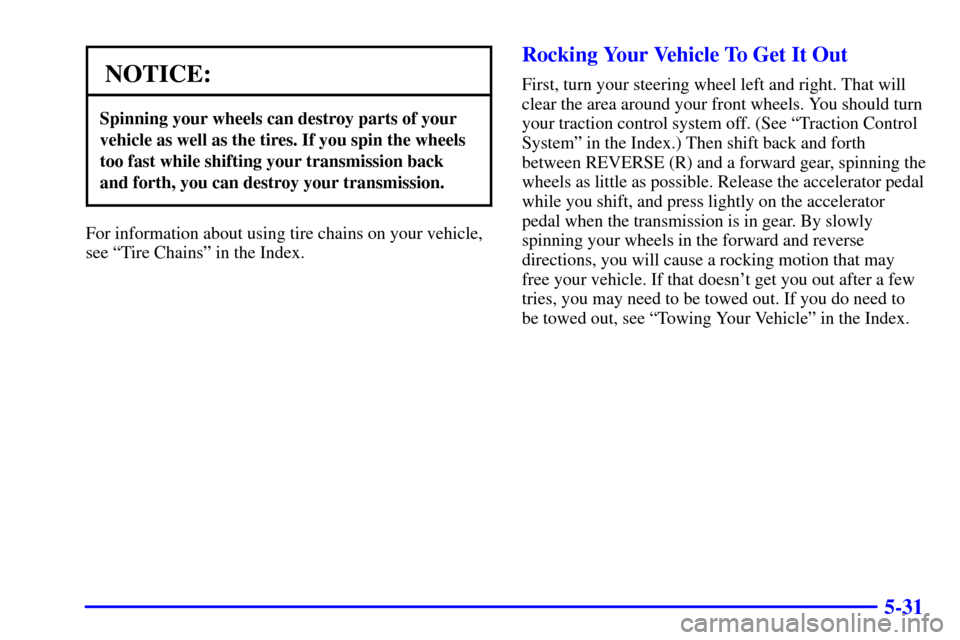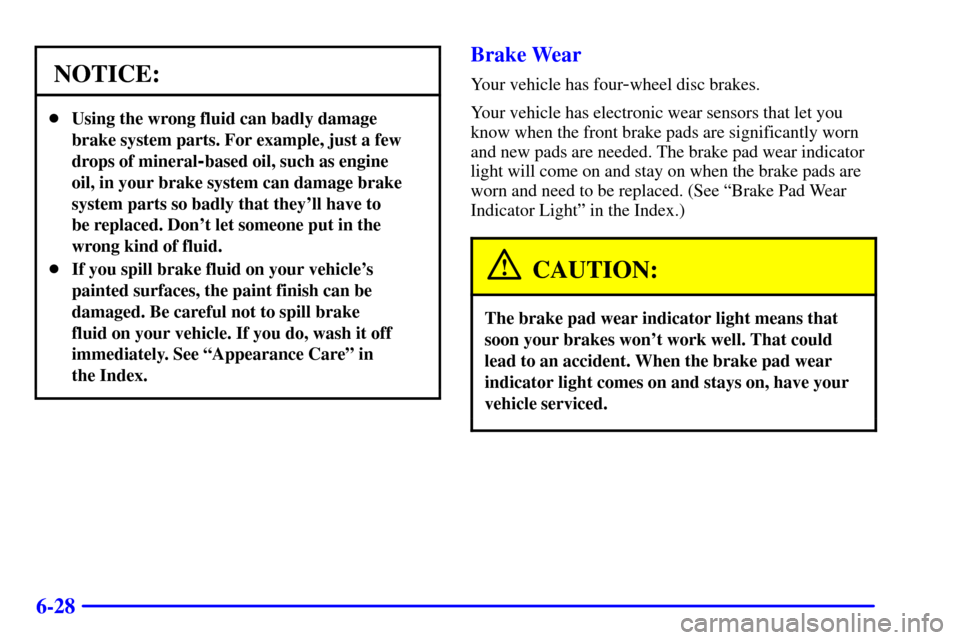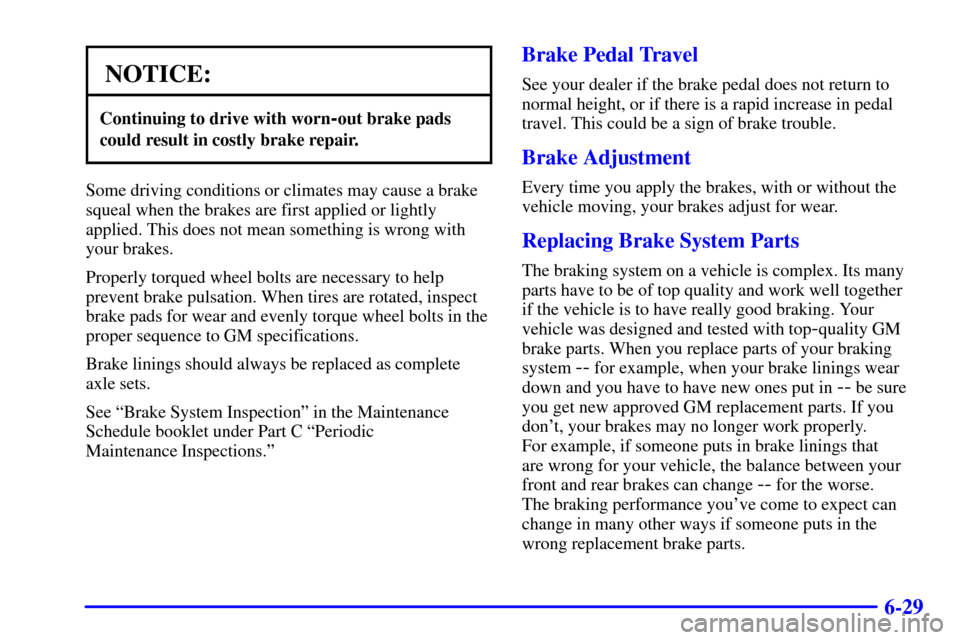Page 240 of 321
5-27
8. Remove any rust or dirt
from the wheel bolts,
mounting surfaces and
spare wheel.
CAUTION:
Rust or dirt on the wheel, or on the parts to
which it is fastened, can make the wheel bolts
become loose after a time. The wheel could come
off and cause an accident. When you change a
wheel, remove any rust or dirt from the places
where the wheel attaches to the vehicle. In an
emergency, you can use a cloth or a paper towel
to do this; but be sure to use a scraper or wire
brush later, if you need to, to get all the rust or
dirt off.
CAUTION:
Never use oil or grease on wheel bolts. If you do,
the bolts might come loose. Your wheel could fall
off, causing a serious accident.
9. Place the spare wheel on the wheel-mounting surface.
10. Replace the wheel bolts.
Tighten each bolt by
hand until the wheel is
held against the hub.
Page 241 of 321
5-28
11. Lower the vehicle by turning the jack handle
counterclockwise. Lower the jack completely. After
removing the jack, slide the jack hoisting notch
cover back in.
Tighten the wheel bolts
firmly in a crisscross
sequence as shown.
CAUTION:
Incorrect wheel bolts or improperly tightened
wheel bolts can cause the wheel to become loose
and even come off. This could lead to an accident.
Be sure to use the correct wheel bolts. If you have
to replace them, be sure to get new GM original
equipment wheel bolts.
Stop somewhere as soon as you can and have
the bolts tightened with a torque wrench to
80 lb
-ft (110 N´m).
Page 242 of 321
5-29
NOTICE:
Improperly tightened wheel bolts can lead to
brake pulsation and rotor damage. To avoid
expensive brake repairs, evenly tighten the wheel
bolts in the proper sequence and to the proper
torque specification.
Storing a Flat or Spare Tire and Tools
CAUTION:
Storing a jack, a tire or other equipment in the
passenger compartment of the vehicle could
cause injury. In a sudden stop or collision, loose
equipment could strike someone. Store all these
in the proper place.
After you've put the spare tire on your vehicle, you'll
need to store the flat tire in the trunk. Use the following
procedure to secure the flat tire in the trunk.
Put the flat tire in the trunk where the spare is stored
(driver's side wheel well). Secure the flat tire with the
straps that are used to hold the spare in place.
Page 243 of 321
5-30
The jacking tools are stored on the passenger's side of
the trunk behind the panel with the red pull handle.
Make sure these tools are properly secured when
not in use.
If You're Stuck: In Sand, Mud,
Ice or Snow
In order to free your vehicle when it is stuck, you will
need to spin the wheels, but you don't want to spin your
wheels too fast. The method known as ªrockingº can
help you get out when you're stuck, but you must
use caution.
CAUTION:
If you let your tires spin at high speed, they can
explode, and you or others could be injured. And,
the transmission or other parts of the vehicle can
overheat. That could cause an engine
compartment fire or other damage. When you're
stuck, spin the wheels as little as possible. Don't
spin the wheels above 35 mph (55 km/h) as shown
on the speedometer.
Page 244 of 321

5-31
NOTICE:
Spinning your wheels can destroy parts of your
vehicle as well as the tires. If you spin the wheels
too fast while shifting your transmission back
and forth, you can destroy your transmission.
For information about using tire chains on your vehicle,
see ªTire Chainsº in the Index.
Rocking Your Vehicle To Get It Out
First, turn your steering wheel left and right. That will
clear the area around your front wheels. You should turn
your traction control system off. (See ªTraction Control
Systemº in the Index.) Then shift back and forth
between REVERSE (R) and a forward gear, spinning the
wheels as little as possible. Release the accelerator pedal
while you shift, and press lightly on the accelerator
pedal when the transmission is in gear. By slowly
spinning your wheels in the forward and reverse
directions, you will cause a rocking motion that may
free your vehicle. If that doesn't get you out after a few
tries, you may need to be towed out. If you do need to
be towed out, see ªTowing Your Vehicleº in the Index.
Page 245 of 321

6-
6-1
Section 6 Service and Appearance Care
Here you will find information about the care of your vehicle. This section begins with service and fuel information,
and then it shows how to check important fluid and lubricant levels. There is also technical information about your
vehicle, and a part devoted to its appearance care.
6
- 2 Service
6
- 3 Fuel
6
- 5 Fuels in Foreign Countries
6
- 5 Filling Your Tank
6
- 9 Checking Things Under the Hood
6
- 11 Engine Oil
6
- 15 Engine Air Cleaner/Filter
6
- 19 Automatic Transmission Fluid
6
- 19 Rear Axle
6
- 20 Engine Coolant
6
- 24 Surge Tank Pressure Cap
6
- 24 Power Steering Fluid
6
- 25 Windshield Washer Fluid
6
- 26 Brakes
6
- 30 Battery
6
- 30 Bulb Replacement6
- 37 Wiper Blade Replacement
6
- 38 Tires
6
- 47 Appearance Care
6
- 47 Cleaning the Inside of Your Vehicle
6
- 49 Care of Safety Belts
6
- 51 Cleaning the Outside of Your Vehicle
6
- 52 Cleaning Aluminum or Chrome-Plated
Wheels (If Equipped)
6
- 53 Underbody Maintenance
6
- 54 GM Vehicle Care/Appearance Materials
6
- 55 Vehicle Identification Number (VIN)
6
- 55 Service Parts Identification Label
6
- 56 Electrical System
6
- 63 Replacement Bulbs
6
- 63 Capacities and Specifications
6
- 64 Normal Maintenance Replacement Parts
Page 272 of 321

6-28
NOTICE:
�Using the wrong fluid can badly damage
brake system parts. For example, just a few
drops of mineral
-based oil, such as engine
oil, in your brake system can damage brake
system parts so badly that they'll have to
be replaced. Don't let someone put in the
wrong kind of fluid.
�If you spill brake fluid on your vehicle's
painted surfaces, the paint finish can be
damaged. Be careful not to spill brake
fluid on your vehicle. If you do, wash it off
immediately. See ªAppearance Careº in
the Index.
Brake Wear
Your vehicle has four-wheel disc brakes.
Your vehicle has electronic wear sensors that let you
know when the front brake pads are significantly worn
and new pads are needed. The brake pad wear indicator
light will come on and stay on when the brake pads are
worn and need to be replaced. (See ªBrake Pad Wear
Indicator Lightº in the Index.)
CAUTION:
The brake pad wear indicator light means that
soon your brakes won't work well. That could
lead to an accident. When the brake pad wear
indicator light comes on and stays on, have your
vehicle serviced.
Page 273 of 321

6-29
NOTICE:
Continuing to drive with worn-out brake pads
could result in costly brake repair.
Some driving conditions or climates may cause a brake
squeal when the brakes are first applied or lightly
applied. This does not mean something is wrong with
your brakes.
Properly torqued wheel bolts are necessary to help
prevent brake pulsation. When tires are rotated, inspect
brake pads for wear and evenly torque wheel bolts in the
proper sequence to GM specifications.
Brake linings should always be replaced as complete
axle sets.
See ªBrake System Inspectionº in the Maintenance
Schedule booklet under Part C ªPeriodic
Maintenance Inspections.º
Brake Pedal Travel
See your dealer if the brake pedal does not return to
normal height, or if there is a rapid increase in pedal
travel. This could be a sign of brake trouble.
Brake Adjustment
Every time you apply the brakes, with or without the
vehicle moving, your brakes adjust for wear.
Replacing Brake System Parts
The braking system on a vehicle is complex. Its many
parts have to be of top quality and work well together
if the vehicle is to have really good braking. Your
vehicle was designed and tested with top
-quality GM
brake parts. When you replace parts of your braking
system
-- for example, when your brake linings wear
down and you have to have new ones put in
-- be sure
you get new approved GM replacement parts. If you
don't, your brakes may no longer work properly.
For example, if someone puts in brake linings that
are wrong for your vehicle, the balance between your
front and rear brakes can change
-- for the worse.
The braking performance you've come to expect can
change in many other ways if someone puts in the
wrong replacement brake parts.